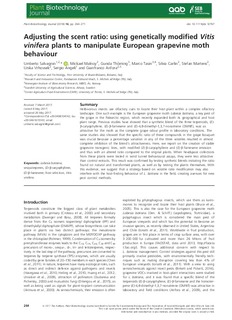| dc.contributor.author | Salvagnin, Umberto | |
| dc.contributor.author | Malnoy, Mickael | |
| dc.contributor.author | Thöming, Gunda | |
| dc.contributor.author | Tasin, Marco | |
| dc.contributor.author | Carlin, Silvia | |
| dc.contributor.author | Martens, Stefan | |
| dc.contributor.author | Vrhovsek, Urska | |
| dc.contributor.author | Angeli, Sergio | |
| dc.contributor.author | Anfora, Gianfranco | |
| dc.date.accessioned | 2018-07-24T08:39:41Z | |
| dc.date.available | 2018-07-24T08:39:41Z | |
| dc.date.created | 2017-10-30T14:16:41Z | |
| dc.date.issued | 2017-06-02 | |
| dc.identifier.citation | Plant Biotechnology Journal. 2017, 16 (1), 264-271. | nb_NO |
| dc.identifier.issn | 1467-7644 | |
| dc.identifier.uri | http://hdl.handle.net/11250/2506334 | |
| dc.description.abstract | Herbivorous insects use olfactory cues to locate their host plant within a complex olfactory landscape. One such example is the European grapevine moth Lobesia botrana, a key pest of the grape in the Palearctic region, which recently expanded both its geographical and host plant range. Previous studies have showed that a synthetic blend of the three terpenoids, (E)-β-caryophyllene, (E)-β-farnesene and (E)-4,8-dimethyl-1,3,7-nonatriene (DMNT), was as attractive for the moth as the complete grape odour profile in laboratory conditions. The same studies also showed that the specific ratio of these compounds in the grape bouquet was crucial because a percentage variation in any of the three volatiles resulted in almost complete inhibition of the blend's attractiveness. Here, we report on the creation of stable grapevine transgenic lines, with modified (E)-β-caryophyllene and (E)-β-farnesene emission and thus with an altered ratio compared to the original plants. When headspace collections from these plants were tested in wind tunnel behavioural assays, they were less attractive than control extracts. This result was confirmed by testing synthetic blends imitating the ratio found on natural and transformed plants, as well as by testing the plants themselves. With this evidence, we suggest that a strategy based on volatile ratio modification may also interfere with the host-finding behaviour of L. botrana in the field, creating avenues for new pest control methods. | nb_NO |
| dc.description.abstract | Adjusting the scent ratio: using genetically modified Vitis vinifera plants to manipulate European grapevine moth behaviour | nb_NO |
| dc.language.iso | eng | nb_NO |
| dc.rights | Navngivelse 4.0 Internasjonal | * |
| dc.rights.uri | http://creativecommons.org/licenses/by/4.0/deed.no | * |
| dc.title | Adjusting the scent ratio: using genetically modified Vitis vinifera plants to manipulate European grapevine moth behaviour | nb_NO |
| dc.title.alternative | Adjusting the scent ratio: using genetically modified Vitis vinifera plants to manipulate European grapevine moth behaviour | nb_NO |
| dc.type | Journal article | nb_NO |
| dc.type | Peer reviewed | nb_NO |
| dc.description.version | publishedVersion | nb_NO |
| dc.rights.holder | © 2017 The Authors. Plant Biotechnology Journal published by Society for Experimental Biology and The Association of Applied Biologists and John Wiley & Sons Ltd. | nb_NO |
| dc.subject.nsi | VDP::Landbruks- og Fiskerifag: 900 | nb_NO |
| dc.subject.nsi | VDP::Landbruks- og Fiskerifag: 900::Landbruksfag: 910::Planteforedling, hagebruk, plantevern, plantepatologi: 911 | nb_NO |
| dc.source.pagenumber | 264-271 | nb_NO |
| dc.source.volume | 16 | nb_NO |
| dc.source.journal | Plant Biotechnology Journal | nb_NO |
| dc.source.issue | 1 | nb_NO |
| dc.identifier.doi | 10.1111/pbi.12767 | |
| dc.identifier.cristin | 1508970 | |
| cristin.ispublished | true | |
| cristin.fulltext | original | |
| cristin.qualitycode | 1 | |

